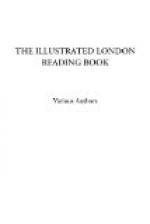All the Crown Jewels, or Regalia, used by the Sovereign on great state occasions, are kept in the Tower of London, where they have been for nearly two centuries. The first express mention made of the Regalia being kept in this palatial fortress, occurs in the reign of Henry III., previously to which they were deposited either in the Treasury of the Temple, or in some religious house dependent upon the Crown. Seldom, however, did the jewels remain in the Tower for any length of time, for they were repeatedly pledged to meet the exigences of the Sovereign. An inventory of the jewels in the Tower, made by order of James I., is of great length; although Henry III., during the Lincolnshire rebellion, in 1536, greatly reduced the value and number of the Royal store. In the reign of Charles II., a desperate attempt was made by Colonel Blood and his accomplices to possess themselves of the Royal Jewels.
The Regalia were originally kept in a small building on the south side of the White Tower; but, in the reign of Charles I., they were transferred to a strong chamber in the Martin Tower, afterwards called the Jewel Tower. Here they remained until the fire in 1840; when being threatened with destruction from the flames which were raging near them, they were carried away by the warders, and placed for safety in the house of the Governor. In 1841 they were removed to the new Jewel-House, which is much more commodious than the old vaulted chamber in which they were previously shown.
[Illustration: QUEEN’S CROWN.]
The QUEEN’S, or IMPERIAL CROWN was made for the coronation of her present Majesty. It is composed of a cap of purple velvet, enclosed by hoops of silver, richly dight with gems, in the form shown in our Illustration. The arches rise almost to a point instead of being depressed, are covered with pearls, and are surmounted by an orb of brilliants. Upon this is placed a Maltese or cross pattee of brilliants. Four crosses and four fleurs-de-lis surmount the circlet, all composed of diamonds, the front cross containing the “inestimable sapphire,” of the purest and deepest azure, more than two inches long, and an inch broad; and, in the circlet beneath it, is a rock ruby, of enormous size and exquisite colour, said to have been worn by the Black Prince at the battle of Cressy, and by Henry V. at the battle of Agincourt. The circlet is enriched with diamonds, emeralds, sapphires, and rubies. This crown was altered from the one constructed expressly for the coronation of King George IV.: the superb diadem then weighed 5-1/2 lb., and was worn by the King on his return in procession from the Abbey to the Hall at Westminster.
[Illustration: OLD IMPERIAL CROWN.]




